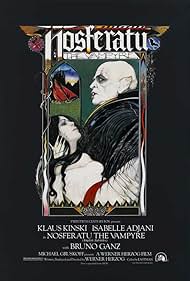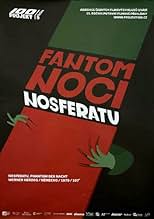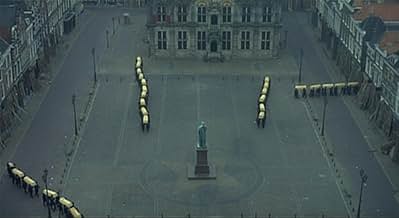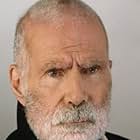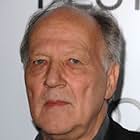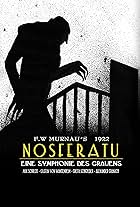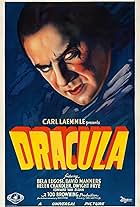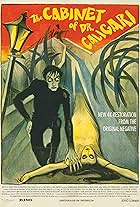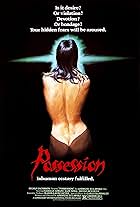Count Dracula moves from Transylvania to Wismar, spreading the Black Plague across the land. Only a woman pure of heart can bring an end to his reign of horror.Count Dracula moves from Transylvania to Wismar, spreading the Black Plague across the land. Only a woman pure of heart can bring an end to his reign of horror.Count Dracula moves from Transylvania to Wismar, spreading the Black Plague across the land. Only a woman pure of heart can bring an end to his reign of horror.
- Awards
- 5 wins & 8 nominations
Rijk de Gooyer
- Town official
- (as Ryk de Gooyer)
Michael Edols
- Lord of the Manor
- (uncredited)
Werner Herzog
- Hand and Feet in Box with Rats
- (uncredited)
Storyline
Did you know
- TriviaKlaus Kinski had to spend approximately four hours per day in make-up. Fresh latex ear pieces had to be poured for each day of shooting because they were destroyed at removal. Kinski, notorious for his violent daily temper-tantrums, had a very good relationship with Japanese make-up artist Reiko Kruk and was exceedingly patient and well-behaved during make-up. Kinski himself said of the make-up that he hated being excessively made up for a role, but for the role of Dracula it was important so he took it in stride. Kinski was so disturbed by his appearance in the make-up that he avoided looking in any mirrors during filming.
- Goofs(at around 58 mins) When the captain of the ship is writing in his log he says they left the Caspian Sea, which is landlocked and nearly 1000 miles away from the port in Bulgaria where the voyage started. Bulgaria is on the Black Sea.
- Quotes
Count Dracula: [subtitled version] Time is an abyss... profound as a thousand nights... Centuries come and go... To be unable to grow old is terrible... Death is not the worst... Can you imagine enduring centuries, experiencing each day the same futilities...
- Alternate versionsThe English-language version was only available in a shorter cut until 2000, which was about 10 minutes shorter.
- ConnectionsEdited into Catalogue of Ships (2008)
- SoundtracksRheingold
Written by Richard Wagner
Performed by Wiener Philharmoniker
Conducted by Georg Solti (as Sir Georg Solti)
Decca LC 0171
Featured review
The vampire genre has seen its share of lackluster films. Indeed, the centerpiece of the grand tradition, the Dracula legend, has seen so many remakes and revisionist attempts that one would be hard pressed to find a version of the tale that is original in its telling. Dracula, like it or not, is a cornerstone of Western society. And it is wholly unfortunate that Bela Lugosi is considered THE Dracula (although Hammer fans may contend that Christopher Lee holds the title since he played the good Count over twenty times).
With Werner Herzog's "Nosferatu: Phantom der Nacht" (also known as "Nosferatu: The Vampyre"), the old Hollywood rules seem to have been thrown out the window in favor of F.W. Murnau's striking silent film, the 1922 masterpiece "Nosferatu: Eine Symphonie der Grauens" ("Nosferatu: A Symphony of Terror"). While many purists of the genre balk at the idea of favoring the Nosferatu tale over the time-tested Tod Browning and Terence Fisher entries, one must realize that the cape-clad widow's peak Count has been sullied by a thousand parodies over time, and is simply not a frightening entity any longer. This was a matter much pondered by Francis Ford Coppola when considering his adaptation. While Gary Oldman's portrayal was serviceable and definitely different, something key was lacking from the tale.
This is what Herzog and his long-time "trouble and strife" lead man Klaus Kinski found when they ventured upon the "Nosferatu" remake. Herzog shifted the attention of the viewer away from the plot, which acts mostly as a backdrop for the imagery, and made it so the primary intake becomes a visual one. Kinski's Dracula is not the scowling insect of the Murnau film. He portrays the Count in a way that no other actor has quite grasped. In this film, Dracula is a suffering being, loathing every moment of his curse's continuation. Of course, as the good Count himself states, "Young men. You are like the villagers. and cannot place yourself in the soul of the hunter." The vampyre is trapped by his instincts, and Kinski's eyes betray harrowing madness (as they did in "Aguirre, der Zorn Gottes"), spiteful malice, and a sorrow so bottomless it defies description. It is as if the beast wishes to weep, but has forgotten how.
Filming on location in Germany, Herzog uses the same dreamlike camera angles, mixing them with a rich color palette and masterful lighting. There is a certain uneasiness that filters outward from the screen as you watch. As Jonathan Harker explores his surroundings during his lodging at Castle Dracula, there is inexplicably a young gypsy boy incessantly playing a scratchy violin under the archway. The surreality of the picture is only matched by its attention to the dark magic of the vampire. Like its predecessor, it actually seems to believe in the creatures, and respects them. It holds the legend, the plight of the people of Wismar, and the plight of the Count himself in deep reverence.
What can be extracted from the dialogue and plot is that this is not your average bloodsuckers extravaganza. In fact, the good Count only sets his fangs to the throat of the living once on screen, and when that occurs, it lends more of a feeling of sacrifice and sorrow than of terror. Indeed, the tone of the film is driven toward tragedy, and does not shift its course. One of the film's more telling moments is when Dracula, alone with Harker's beloved Lucy, ventures to plead with the beautiful lady, "Will you come to me. become my ally? Bring salvation to your husband. and to me. The absence of love. is the most abject pain." When she refuses, he does not lash out or decide to make a meal of her then and there. He instead moans with the intonation of a wounded animal and slinks off into the night.
"Nosferatu: Phantom der Nacht" is the most complete of vampire films, and towers over the genre. It could be considered a pity that the only film that sits upon its coattails is its predecessor of the same name. Under Herzog's direction (wisely choosing to avoid remaking classic shots), we get an entirely different film that exudes an entirely different feeling. It not only maintains the eerie horror that the genre deserves, but also achieves a beauty and mystique that has been lost over the years. A must-see.
With Werner Herzog's "Nosferatu: Phantom der Nacht" (also known as "Nosferatu: The Vampyre"), the old Hollywood rules seem to have been thrown out the window in favor of F.W. Murnau's striking silent film, the 1922 masterpiece "Nosferatu: Eine Symphonie der Grauens" ("Nosferatu: A Symphony of Terror"). While many purists of the genre balk at the idea of favoring the Nosferatu tale over the time-tested Tod Browning and Terence Fisher entries, one must realize that the cape-clad widow's peak Count has been sullied by a thousand parodies over time, and is simply not a frightening entity any longer. This was a matter much pondered by Francis Ford Coppola when considering his adaptation. While Gary Oldman's portrayal was serviceable and definitely different, something key was lacking from the tale.
This is what Herzog and his long-time "trouble and strife" lead man Klaus Kinski found when they ventured upon the "Nosferatu" remake. Herzog shifted the attention of the viewer away from the plot, which acts mostly as a backdrop for the imagery, and made it so the primary intake becomes a visual one. Kinski's Dracula is not the scowling insect of the Murnau film. He portrays the Count in a way that no other actor has quite grasped. In this film, Dracula is a suffering being, loathing every moment of his curse's continuation. Of course, as the good Count himself states, "Young men. You are like the villagers. and cannot place yourself in the soul of the hunter." The vampyre is trapped by his instincts, and Kinski's eyes betray harrowing madness (as they did in "Aguirre, der Zorn Gottes"), spiteful malice, and a sorrow so bottomless it defies description. It is as if the beast wishes to weep, but has forgotten how.
Filming on location in Germany, Herzog uses the same dreamlike camera angles, mixing them with a rich color palette and masterful lighting. There is a certain uneasiness that filters outward from the screen as you watch. As Jonathan Harker explores his surroundings during his lodging at Castle Dracula, there is inexplicably a young gypsy boy incessantly playing a scratchy violin under the archway. The surreality of the picture is only matched by its attention to the dark magic of the vampire. Like its predecessor, it actually seems to believe in the creatures, and respects them. It holds the legend, the plight of the people of Wismar, and the plight of the Count himself in deep reverence.
What can be extracted from the dialogue and plot is that this is not your average bloodsuckers extravaganza. In fact, the good Count only sets his fangs to the throat of the living once on screen, and when that occurs, it lends more of a feeling of sacrifice and sorrow than of terror. Indeed, the tone of the film is driven toward tragedy, and does not shift its course. One of the film's more telling moments is when Dracula, alone with Harker's beloved Lucy, ventures to plead with the beautiful lady, "Will you come to me. become my ally? Bring salvation to your husband. and to me. The absence of love. is the most abject pain." When she refuses, he does not lash out or decide to make a meal of her then and there. He instead moans with the intonation of a wounded animal and slinks off into the night.
"Nosferatu: Phantom der Nacht" is the most complete of vampire films, and towers over the genre. It could be considered a pity that the only film that sits upon its coattails is its predecessor of the same name. Under Herzog's direction (wisely choosing to avoid remaking classic shots), we get an entirely different film that exudes an entirely different feeling. It not only maintains the eerie horror that the genre deserves, but also achieves a beauty and mystique that has been lost over the years. A must-see.
- kilgres_bloodmoon
- Feb 10, 2001
- Permalink
Details
- Release date
- Countries of origin
- Languages
- Also known as
- Nosferatu, vampiro de la noche
- Filming locations
- Delft, Zuid-Holland, Netherlands(many exteriors)
- Production companies
- See more company credits at IMDbPro
Box office
- Gross worldwide
- $3,389
- Runtime1 hour 47 minutes
- Sound mix
- Aspect ratio
- 1.85 : 1
Contribute to this page
Suggest an edit or add missing content

